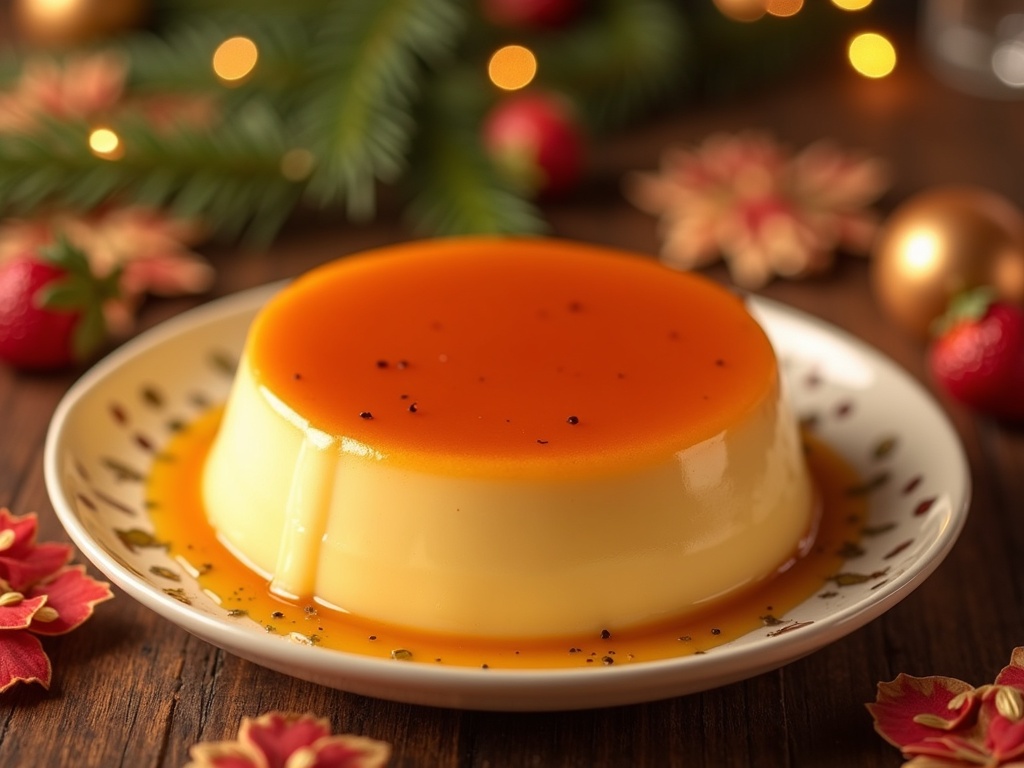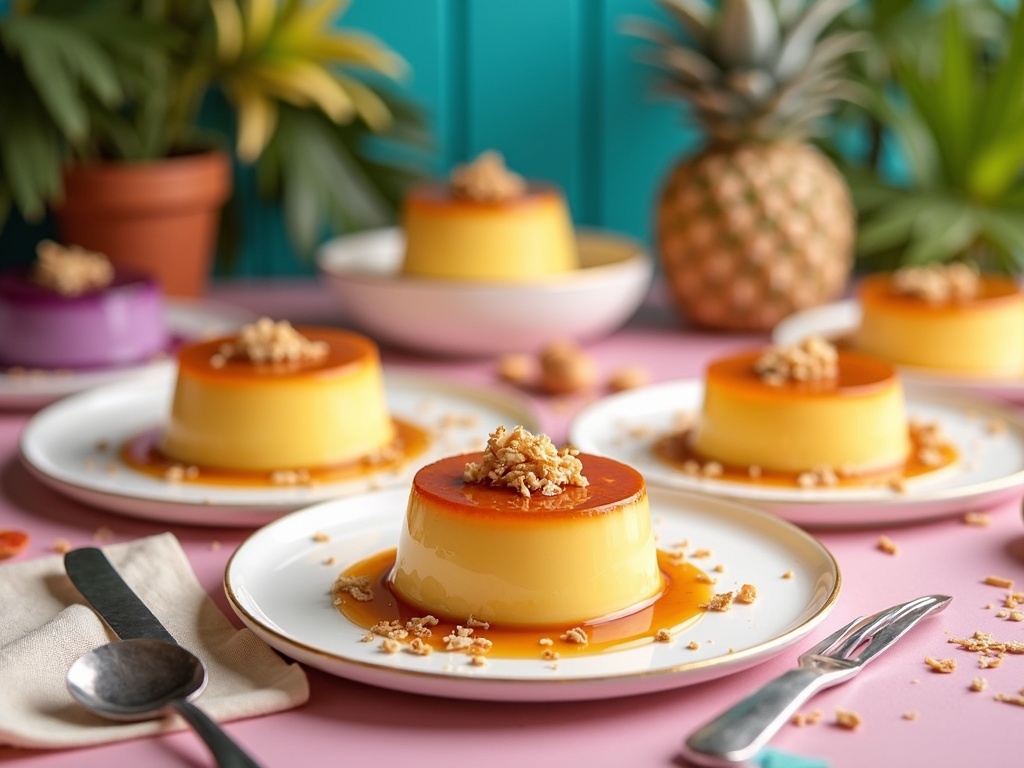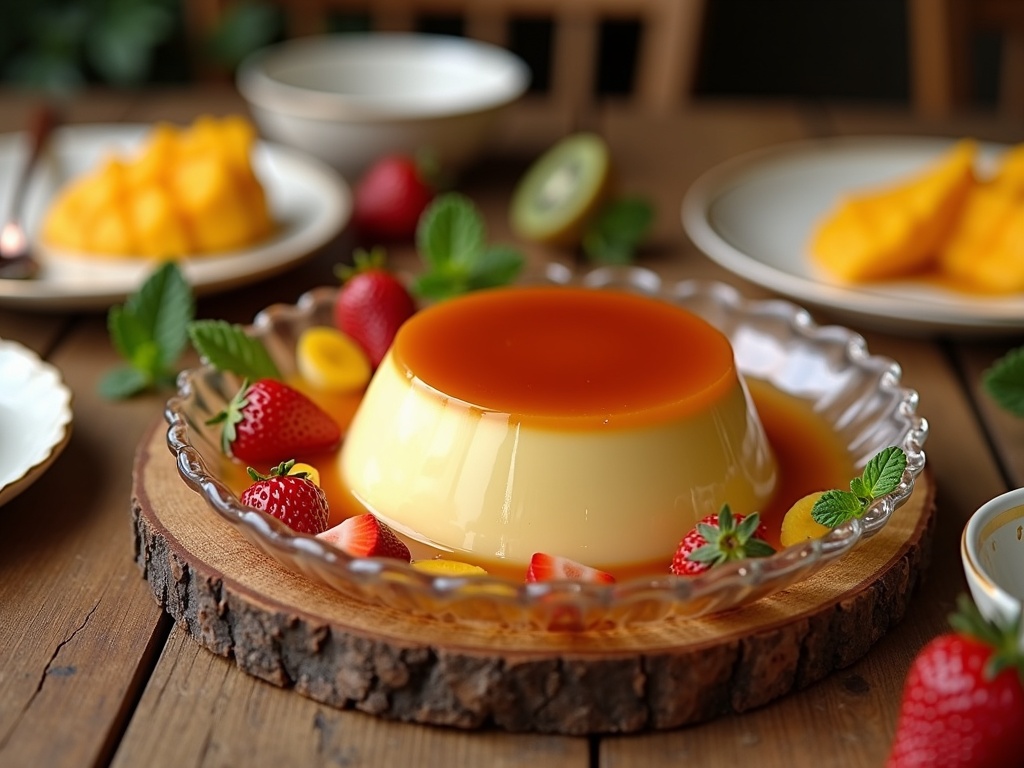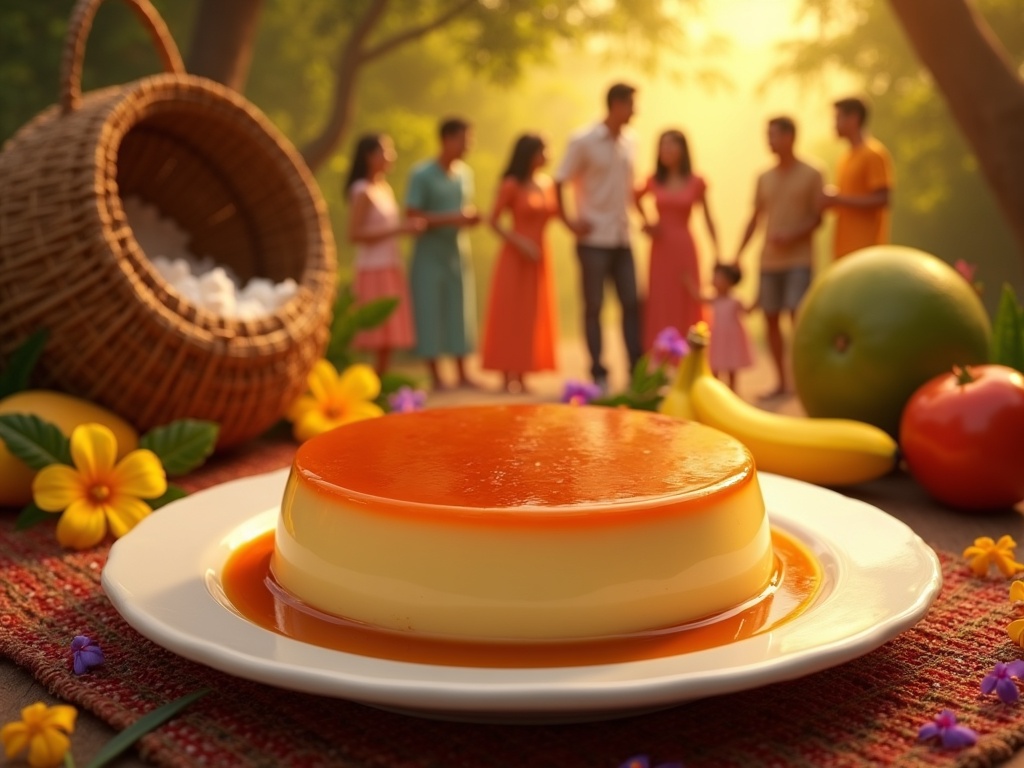Leche flan, a silky custard dessert with sweet caramel topping, represents a delicious cultural fusion that arrived in the Philippines during Spanish colonization in the 16th century. Filipinos transformed this Spanish import by incorporating local ingredients like coconut milk and additional egg yolks, creating a richer, denser dessert that has become a symbol of prosperity and a staple at Filipino celebrations.
Find In This Article
Key Takeaways
- Leche flan originated in Spain and was introduced to the Philippines during the Spanish colonial period, with “leche” meaning milk in Spanish.
- Filipino versions typically use more egg yolks than Spanish versions, creating a denser texture and often incorporate local ingredients like coconut milk or water buffalo milk.
- The dessert holds cultural significance as a symbol of prosperity in Filipino culture, commonly served at special occasions like birthdays, Christmas, and fiestas.
- Traditional leche flan requires simple ingredients (eggs, condensed milk, evaporated milk, and sugar) but demands careful technique for the perfect caramel and silky texture.
- Modern variations include flavor innovations like ube (purple yam) and coconut, as well as dietary adaptations for vegan and lactose-free diets.
This Beloved Filipino Dessert Has Spanish Roots
Leche flan holds a special place in Filipino culture, with its silky texture and sweet caramel topping making it a staple at celebrations. This iconic dessert didn’t originate in the Philippines but arrived during the Spanish colonial period in the 16th century when Spain established its presence in the archipelago.
The name itself reveals its heritage – “leche” means milk in Spanish, pointing to the dessert’s primary ingredient. When the Spanish introduced their traditional custard dessert to the Philippines, they brought along cooking techniques and flavor profiles that would evolve over centuries of cultural exchange.
A Delicious Cultural Fusion
What makes Filipino leche flan distinct from its Spanish predecessor is the creative adaptation using local ingredients. Over time, Filipinos incorporated:
- Coconut milk as a substitute or complement to dairy milk
- Carabao (water buffalo) milk for added richness
- More egg yolks than the Spanish version, creating a denser texture
- Palm sugar in some regions instead of traditional white sugar
I’ve found that these adaptations reflect the resourcefulness of Filipino cooks who transformed a foreign dessert into something uniquely their own. The result is typically richer and more decadent than crème caramel desserts found elsewhere.
The dessert became deeply integrated into Filipino culinary traditions, often served during special occasions like birthdays, Christmas celebrations, and fiestas. Leche flan symbolizes prosperity in Filipino culture, with its golden color and rich ingredients representing abundance and good fortune.
Today, leche flan appears in countless Filipino homes and restaurants, with each family often guarding their special recipe. It’s a testament to how food evolves across cultures while maintaining connections to its origins. The dessert stands as a delicious reminder of the complex cultural exchanges that have shaped Filipino cuisine over centuries.
This sweet treat is just one example of the fascinating Filipino dessert traditions that blend colonial influences with native ingenuity. The next time you enjoy a slice of leche flan, you’re tasting not just a dessert but centuries of cultural history in each spoonful.
How to Make the Perfect Leche Flan
I’ve discovered that creating the perfect leche flan requires attention to detail and quality ingredients. This Filipino custard dessert, similar to crème caramel, combines a silky egg custard with a rich caramel topping that creates a show-stopping effect when flipped onto a serving plate.
Essential Ingredients
The foundation of a stunning leche flan starts with just a few simple ingredients:
- 4-6 large eggs (room temperature for best results)
- 1 cup sweetened condensed milk
- 1 cup evaporated milk
- 1 cup sugar (for caramelizing)
The quality of your eggs makes a significant difference in the final texture. Fresh eggs with bright orange yolks create a more vibrant, richer custard. I always set my eggs out about 30 minutes before starting to ensure they incorporate smoothly.
Mastering the Technique
The magic of leche flan happens in two key steps – the caramelization process and the custard preparation.
For perfect caramel, heat your sugar in a heavy-bottomed pan over medium heat. Resist the urge to stir constantly – instead, gently swirl the pan as the sugar melts. You’re looking for a deep amber color that’s not too dark. Pour this immediately into your flan molds, tilting to coat the bottom and slightly up the sides.
For the custard, whisk the eggs gently but thoroughly, avoiding excess air bubbles. Then combine with both condensed and evaporated milk. The condensed milk provides sweetness while the evaporated milk creates richness without thinning the mixture.
Strain this mixture through a fine sieve to remove any egg chalazae (the white stringy bits) before pouring over your caramelized sugar. This simple step is critical for achieving that signature silky smooth texture that makes desserts like leche flan so special.
The water bath (bain-marie) cooking method prevents the custard from curdling by providing gentle, even heat. Your flan is done when the edges are set but the center still has a slight jiggle – it will continue firming up as it cools.
After cooling, refrigerate your flan for at least 4 hours or preferably overnight. This resting period allows the caramel to soften and infuse into the custard, creating that distinctive flavor contrast between the sweet caramel and creamy custard.
When you’re ready to serve, run a thin knife around the edges and invert onto a plate with a lip to catch all that luscious caramel sauce.
What Makes It a Special Occasion Treat
Leche flan stands as a cornerstone dessert in Filipino celebrations, gracing tables during the most significant life events. I’ve noticed how this silky custard with its amber caramel top appears at virtually every important gathering in Filipino culture. Its presence at weddings symbolizes the sweet beginning of married life, while at birthdays, it represents the sweetness of another blessed year.
During Christmas, particularly at Noche Buena (the traditional Filipino Christmas Eve feast), leche flan takes a place of honor among the spread. This midnight feast brings families together, and the unmistakable oval llanera filled with this creamy caramel dessert signals that the celebration is complete.
More Than Just Dessert
Leche flan serves as a centerpiece that brings deeper meaning to gatherings. When placed at the center of the table, it becomes more than food—it transforms into a symbol of family unity and shared heritage. The ritual of preparing this dessert often involves multiple generations:
- Grandmothers pass down their secret techniques for achieving the perfect caramel
- Mothers teach children the proper way to separate eggs
- Cousins gather to taste-test the finished product
- Fathers often claim the honor of flipping the finished flan onto the serving plate
The emotional connection to leche flan runs deep for many Filipinos. One bite can transport someone back to childhood celebrations or remind them of a loved one who made it best. This nostalgic quality makes it irreplaceable in the lineup of traditional desserts at important events.
I’ve observed how Filipino celebrations feel incomplete without this beloved dessert. Whether it’s a simple family gathering or an elaborate wedding reception, guests often scan the dessert table specifically looking for leche flan. Its absence would be noticed immediately, much like missing a family member at the celebration.
The anticipation of seeing that perfect wobble as the flan is served, followed by the collective sigh of appreciation when the first piece reveals its perfect texture, creates a shared experience that strengthens family bonds and cultural identity—making leche flan not just food, but a treasured tradition that connects generations.

Modern Takes on the Classic Recipe
I’ve discovered some exciting ways to reinvent the traditional leche flan while keeping its custardy goodness intact. These contemporary variations add surprising flavors and cater to different dietary needs without sacrificing the dessert’s iconic texture.
Flavor Innovations
Ube Leche Flan combines the classic custard with the nutty, vanilla-like taste of purple yam. I simply mix ube halaya (purple yam jam) into the custard mixture before baking. The result is a stunning purple-hued dessert with a unique flavor profile that’s become incredibly popular in fusion dessert scenes.
Coconut Leche Flan offers a tropical twist by substituting some or all of the regular milk with rich coconut cream. This creates a more fragrant flan with subtle coconut notes that complement the caramelized sugar perfectly. For an extra touch, I sometimes garnish with toasted coconut flakes for added texture and visual appeal.
Cheese Flan introduces a delightful salty-sweet contrast that’s irresistible. By adding cream cheese or even queso de bola to the custard base, I create a more complex flavor profile. The slight tanginess cuts through the sweetness, making it less cloying than traditional crème caramel recipes.
Dietary Adaptations
For those following plant-based diets, Vegan Leche Flan substitutes eggs with silken tofu, creating a remarkably similar texture. The key is blending the tofu until completely smooth and adding a bit of cornstarch as a binder. I’ve found that nutritional yeast can add that subtle eggy flavor that traditional flans have.
Lactose-free milk alternatives work surprisingly well in leche flan recipes. Whether using almond, soy, or oat milk, I adjust the fat content by adding a touch of coconut oil to maintain that rich mouthfeel that makes desserts like leche flan so satisfying.
These modern variations show just how versatile leche flan can be. By experimenting with different flavors and ingredients, I’ve found that this classic dessert can evolve while still honoring its roots. Each adaptation offers a new way to enjoy this beloved custard, whether you’re looking to explore new flavor combinations or accommodate dietary restrictions without missing out on one of the world’s most beloved caramel desserts.

Know Before You Indulge: Nutrition Facts
I’ve always believed in enjoying delicious desserts like leche flan while staying informed about what I’m putting in my body. This Filipino custard treat delivers a rich experience that satisfies sweet cravings, but it’s helpful to understand its nutritional profile before digging in.
Nutritional Breakdown
When enjoying leche flan, I’m mindful that a standard 100g serving contains approximately 320 calories. This makes it a more substantial dessert option compared to some lighter treats. The total fat content sits at about 12g per serving, with 6g coming from saturated fats—something to consider if I’m watching my fat intake.
For those tracking cholesterol, leche flan contains around 120mg per serving due to its egg-rich composition. The sodium content is moderate at approximately 100mg per 100g portion.
Where leche flan really delivers is in its carbohydrate content. Here’s what you can expect in each serving:
- 45g total carbohydrates
- 30g sugars (from the caramelized sugar topping and sweetened condensed milk)
- 6g protein (primarily from eggs)
This protein content actually gives leche flan a slight nutritional edge over some other desserts that might offer less protein per serving. The eggs in the recipe provide high-quality protein along with various nutrients.
I’ve found that leche flan makes for an excellent special occasion dessert rather than an everyday indulgence. Its rich nutritional profile means it’s best enjoyed in moderation, perhaps with a smaller portion size if you’re mindful of calorie intake.
When serving leche flan at gatherings, I sometimes pair it with fresh fruit to add nutritional balance and cut through the richness. This creates a more complete dessert experience while adding valuable nutrients to the overall plate.
Understanding these nutrition facts doesn’t mean avoiding this delicious treat altogether—just enjoying it mindfully while appreciating its place in a balanced approach to eating.

Sources:
Philippine Culinary Heritage: Philippine Flan: History and Recipes
Food and Culture Journal: The Richness of Leche Flan
Journal of Food Science and Nutrition: Nutritional Analysis of Traditional Filipino Desserts
The Filipino Food Magazine: Leche Flan and Its Role in Filipino Celebrations

